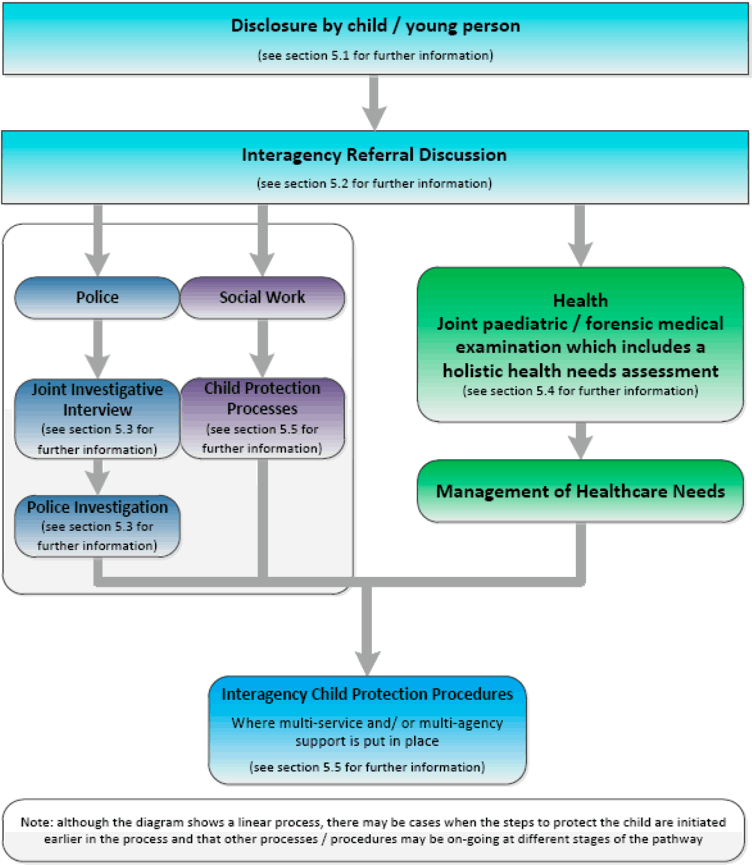Clinical pathway for children and young people who have disclosed sexual abuse: consultation
This pathway is relevant for children under 16 years of age (or up to 18 years of age for young people with vulnerabilities and additional support needs).
5. Clinical Pathway Processes
The diagram below provides a high level summary of the clinical pathway and the specific steps to take during the process. Detail on each of the steps is provided in the sections following the diagram.

5.1 Disclosure by a child / young person
The majority of sexual abuse disclosures in children are historic rather than recent; therefore not all disclosures require an urgent medical response. Young people may self-refer to any agency, including health services. Any disclosure of sexual abuse in child aged under 16 years must be considered as a potential child protection concern.
Children and young people may disclose sexual abuse in many ways, or concerns may be raised from their behaviour or presenting symptoms. It is recognised that often it can take some time for a disclosure to become apparent (NSPCC). It is important that there is a robust, timely, trauma-informed response to cases of acute or recent sexual abuse as well as to disclosures of historical abuse.
At all points in the pathway, the primary focus is the child or young person and their immediate and future wellbeing, informed by the GIRFEC principles and values. The potential impact on those close to the child is acknowledged and the need to offer these people appropriate support as required. Work is being undertaken as part of the CMO Taskforce to explore enhanced provision of family support services.
Sexual abuse in children may present in a number of ways including but not limited to:
- Disclosure by the child of previous / ongoing abuse: A clear allegation is often not made at an early stage in the process as the abuser may groom and/or threaten the child. If the child alleges acute sexual abuse urgent action is required.
- Pregnancy or sexually transmitted infection in a child under 16 years – this should always prompt further enquiry and exploration.
- Behavioural change including sexualised behaviour.
- Unexplained genital bleeding or injury or history not compatible with symptoms and examination.
- Any sexual activity in a child who is under 13 years.
- Foreign body present in vagina or anus.
- Recurrent or new onset wetting or soiling.
- A perpetrator of abuse who may be, or may have been, a victim themselves.
5.2 Interagency Referral Discussion (IRD)
The IRD is an interagency discussion including police, social work and health that usually occurs within the first 24 hours after initial disclosure being received by any agency. It will include consideration of the following:
- Immediate safety of child and any other children living within the house.
- Collection of early evidence by police / health services if required.
- Timing, sequence and site of joint interview and joint paediatric / forensic medical examination.
- Consent for medical examination.
National Guidance for Child Protection in Scotland (2014) advises that health practitioners have a duty of care to share information and plan the response and investigation in line with the child’s needs once they are aware of a concern or disclosure of sexual abuse. In Scotland, a range of professionals including health professionals should always be involved in an IRD. The IRD aims to share information and identify the risks to the child (and other children in the household) so that immediate safeguarding measures can be taken. The IRD should also enable planning of possible interview and examination of the child to further investigate the concerns.
The paediatrician involved in the planning discussion should take responsibility for taking the medical assessment forward, agreeing with police and social work colleagues the type of examination, timing and venue (National Guidance for Child Protection in Scotland (2014) and local guidance for IRDs.
5.3 Police and Social Work
Joint Investigative Interview (JII)
JII is the formal interview process carried out by police and social work investigative interviewers mainly for evidential purposes and to assess if necessary, whether the child (or any other child) is in need of protection.
The interview is conducted in a way that treats the best interests of the child as a primary consideration and includes the gathering of evidence when it is suspected a crime may have been committed against or witnessed by the child, and gathering of evidence which may lead to a ground for referral to a children‘s hearing being established.
Police Investigation
Information obtained during the Joint Investigative Interview is fed back into the IRD process to allow further discussion and decision making.
5.4 Health - Joint paediatric / forensic medical examination and management of healthcare needs
Further information on the joint paediatric / forensic examination is available in section 6 along with considerations for the medical examination and follow up.
5.5 Interagency Child Protection Procedures
For further information on interagency child protection procedures, please refer to:
- National Guidance for Child Protection in Scotland (Scottish Government 2014)
- Child Protection Guidance for Health Professionals (Scottish Government 2013)
For further information on child protection processes, please refer to the interagency child protection guidelines for your local area.
The Child’s Plan (GIRFEC) may include access to ongoing therapeutic support for the child and their family members / carers post examination, but also in the months and years following disclosure of Child Sexual Abuse (CSA).
Contact
Email: Vicky.Carmichael@gov.scot
There is a problem
Thanks for your feedback